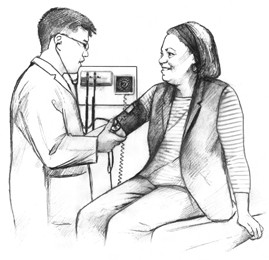Heart disease in women + 5 ways to protect your heart!

When you think of what a heart attack looks like, what do you see?
Do you see someone clutching their chest and gasping for breath? Is this someone a man?
Growing up, I thought heart attacks only impacted men – when I would see a heart attack happen on a commercial or a movie, I would witness a dramatic scene, where a man suddenly clutches his chest and everyone rushes to his side.
What I didn’t know is that heart disease is the leading cause of death for women in our country.
1 out of 3 women die each year from heart disease in the United States.
90% of women have one or more risk factors for developing heart disease. What’s more, people of color also face a great risk of heart disease. Heart disease is the leading cause of death for African American women, and Hispanic women are likely to develop heart disease 10 years earlier than Caucasian women.
The symptoms of heart disease or more specifically, a heart attack, can be unique in women, and are often misunderstood. While men may commonly experience squeezing of the chest after exercise, stress, or a large meal, women may experience vague, harder to read symptoms, such as:
- Fatigue
- Mid-back pain
- Jaw pain
- Confusion
- Fainting
- Stomach pain
- Vomiting
If you aren’t feeling normal, and you are experiencing any of the symptoms above, call 911. As Dr. Suzanne Steinbaum says: “A women’s intuition is a very strong thing; don’t ever discount it.”
Here are 5 things you can do today to reduce your risk for heart disease:
1. Manage your stress. 
Too much stress is detrimental to our health, but for many of us, reducing or eliminating all of our stress completely may not be possible. Learning a variety of techniques on how to respond to and manage the stress in our lives helps us to not only stay afloat, but also to bounce back. The four techniques developed by the Mayo Clinic are easy to remember, all beginning with the letter A:
- Avoid: Are there things that I can avoid? If I know traffic always stresses me out, I can try leaving early to avoid the traffic, or heading out later. Are there things I need to say no to, in order to say yes to others?
- Alter: Is there a small change I can make that can change the big picture? Like making a slight change to my schedule, or expressing what I need and how I feel to someone?
- Adapt: When I take a step back and look at the big picture, does this really matter in the long run? Do I need to adjust my expectations? What do I need to do to take care of myself right now?
- Accept: What can I let go of that is out of my control? What opportunity may come from this situation that I’m not able to see right now?
2. Swap the salt. 
While sodium helps control our body’s fluid balance, send messages through our nerve system, and affects our muscle function, too much sodium can result in serious consequences. When we have too much sodium in our blood stream, excess water builds up in our blood vessels, increasing the volume of blood inside, leading to an increase in blood pressure. High blood pressure is one of the major risk factors of heart disease. Worried that your food won’t taste as good without salt? Add some spices and herbs, like cumin, ginger, cilantro, basil or thyme. Check out these great salt-free seasoning blends recommended by the Boston Public Health Commission.
3. Get moving.
Our bodies need stamina and strength to get us through our busy days, and our heart is a muscle that needs exercise to help keep it fit so it can keep pumping blood through our body. The American Heart Association recommends that adults get 150 minutes of exercise per week, which can amount to 30 minutes a day for five days. If you don’t have a gym membership, that’s fine! You can get your exercise in through getting off the bus a few stops early to walk the rest of the way, ditching the elevator for the stairs, or dancing to your favorite music. Talk to your doctor about what level of exercise and fitness is right for you.
4. Quit smoking.
Did you know that smoking can not only cause lung cancer, but also increase your risk for a heart attack or a stroke? Did you know that women who smoke are at a higher risk of having a heart attack than men who smoke? If you are a woman and smoke three to five cigarettes a day, you double your risk of heart attack. A man would have to smoke six to nine cigarettes a day to double his risk. Quitting smoking is not easy. Contact the Massachusetts Smokers’ Helpline for support and specialized coaching on how to quit today: 1-800-QUITNOW (1-800-784-8669)
5. Know your body and talk to your doctor.
Getting to know our bodies is essential to reducing our risk for heart disease. If we’re not checking in with ourselves and our bodies, we may not know if what we’re feeling is just fatigue after a big meal, or a symptom of a heart attack. Tune in to what your body is trying to tell you, and don’t be afraid to call 911 or your doctor if you feel that something is not right. Share your family history and lifestyle practices with your doctor, so the two of you can make the best decisions for your health. Ask your healthcare provider to share your blood pressure numbers, your blood glucose levels and your blood cholesterol to learn more about your risk for heart disease. Learn more about important questions to ask your doctor about heart health.


